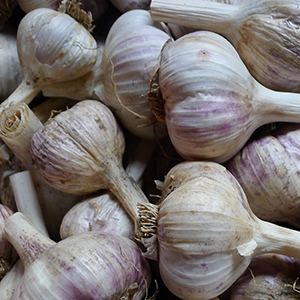
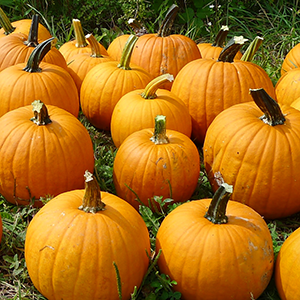
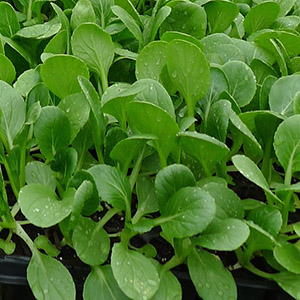

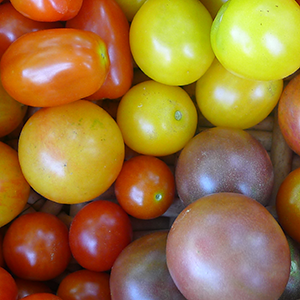
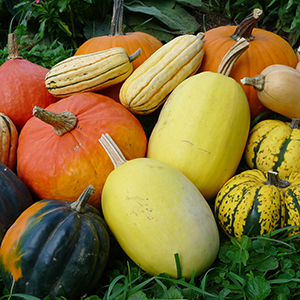
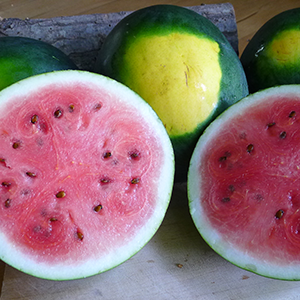



News and Notes | The Anchor Run Blog
Posts Filtered by Month - June 2019 |
Show Recent Posts
June 30, 2019
Orange Carrot Bloom
by Farmer Dana
Orange Carrot Bloom
by Farmer Dana
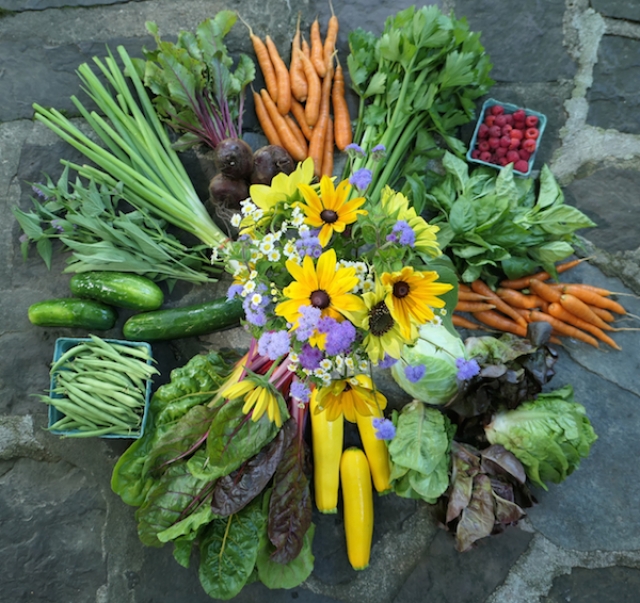
Harvest #8 (Week B) should include beets, carrots, cucumbers, yellow/green zucchini, lettuce, kale, chard, Italian dandelion, celery, cabbage, scallions, basil, cilantro, dill, and parsley. U-pick should include raspberries, snap/string beans, flowers, and herbs.
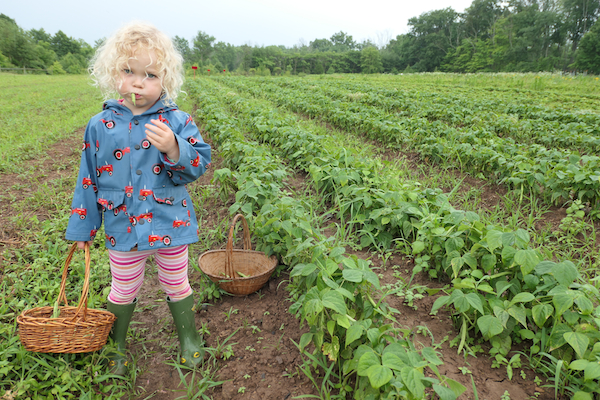
Green snap/string beans, kid tested, kid approved.

June 30, 2019
Workshifts for Week of 7/1/19
by Farmer Derek
Workshifts for Week of 7/1/19
by Farmer Derek
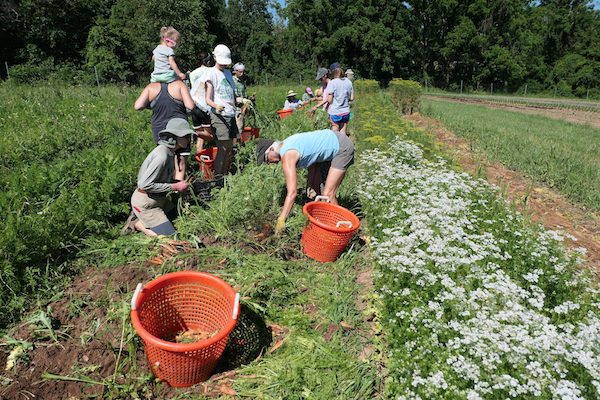
Hard-working members helping hard-working farmers harvest carrots!
Workshifts scheduled for this week:
Tuesday (7/2) 9-11am
Wednesday (7/3) 9-11am & 6-8pm
Friday (7/5) 9-11am
Sunday (7/7) 9-11am
Workshift sign-up instructions may be found here.
Help your farmers pull some weeds and harvest this week! We still have 20% of the carrots to harvest.
If it is actively raining during the time of the shift it will be canceled.

June 30, 2019
From Wet to Dry, Thankfully
by Farmer Derek
From Wet to Dry, Thankfully
by Farmer Derek
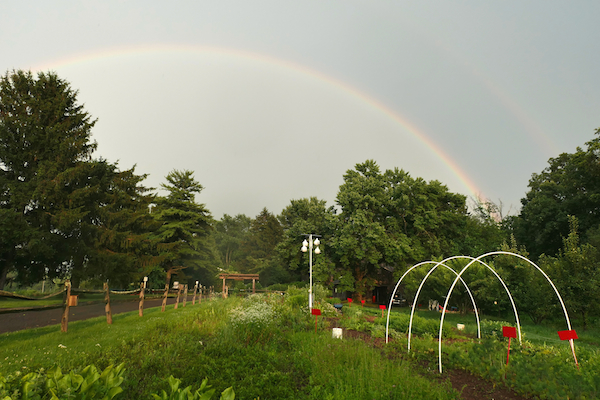
A brief passing shower gave us rainbow glory.
The rounds of thunderstorms that rolled through the area Friday and Saturday evenings spared the farm an inundation but did provide a nice double rainbow. Following a week with 4" of rain we desperately needed a period of dry weather. Any more rain probably would have doomed the carrots but it fortunately seems most of the patch is harvestable.
We were able to resume all of the required field work last week including cultivating leeks, celeriac, lettuces, herbs, beans, and edamame. Tomatoes were pruned and trellised again. Weekly beans and lettuces were transplanted. Spring crops were mowed, compost was spread, and then the ground was chisel-plowed to stimulate decomposition before we sow cover crops. Land for fall crops of beets, chard, carrots, lettuce, broccoli, cabbage, cauliflower, and kale was loosened with the chisel plow again but this time around with the added extra tillage of a row of s-tines on the back to rid the soil of germinating weeds and persistent grasses. Because the shanks on the chisel plow are spaced 12" apart weeds can sometimes survive a pass in the gaps between shanks. Adding the s-tines on the back, which are placed in the space between the chisel shanks, the top of the soil profile is disturbed more completely.
This time of year when preparing soil that had been in a winter cover crop such as wheat, vetch, and/or clover requires two passes with the flail mower, an initial chisel, another chisel with the s-tines, then we begin making our raised beds which requires a pass with the primary shaper then two passes with the final shaper (with each shaper pass we drop organic fertilizer). In between each pass with the tractor we ideally receive some rain to entice weeds to germinate which are then terminated by the next tractor pass. Preparing soil that has been fallowed for a longer period of time and is typically taken over by perennial grasses and clovers requires an extra pass or two with a chisel plow or disk harrow before we can begin making beds. The process takes place over a month or two.
We've modified our soil prep techniques over the years to retain proper soil structure as well as increase organic matter even though it takes a longer period of time to prepare soil for planting. Contrast these extra steps with spring planting after winter-killed cover crops (oats, buckwheat, radish) which normally requires only one pass with the chisel plow followed by bed shaping.
Why is this important you ask? Good question. For several reasons: Each pass with the tractor takes time and fuel. When soil is disturbed the biology, chemistry, and physical properties are interacted/interfered with. Thus our goal is to find that intersection where reduced time on the tractor meets improved soil health meets good planting conditions. We believe properly used tillage and farming techniques can greatly improve soil (and produce) over time.
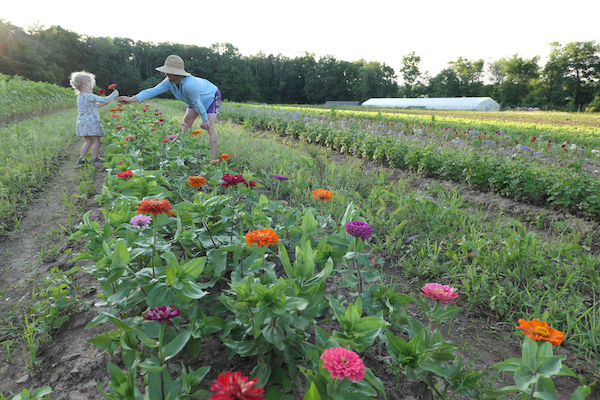
U-pick flowers opened up last week with not one but two locations available for picking. Rudbeckia aka black eyed susans volunteered in the strawberry patch in addition to the planned cut-flower patch.

June 23, 2019
Deluge Survivors
by Farmer Dana
Deluge Survivors
by Farmer Dana
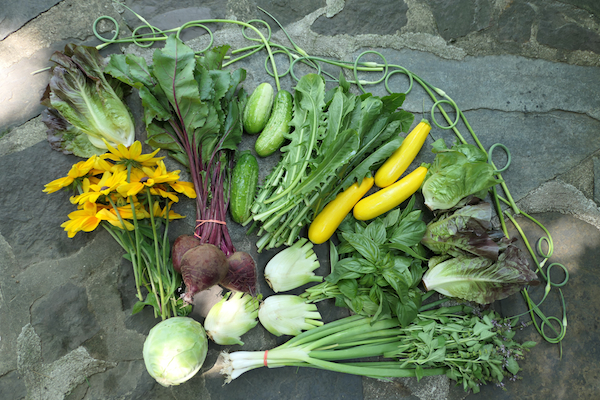
Harvest #7 (Week A) should include beets, cucumbers, zucchini, scallions, garlic scapes, cabbage, lettuce, kale, chard, Italian dandelion, radicchio, hakurei turnips, fennel, cilantro, dill, parsley, and basil. U-pick should include flowers and herbs.

June 23, 2019
Workshifts for Week of 6/24/19
by Farmer Derek
Workshifts for Week of 6/24/19
by Farmer Derek
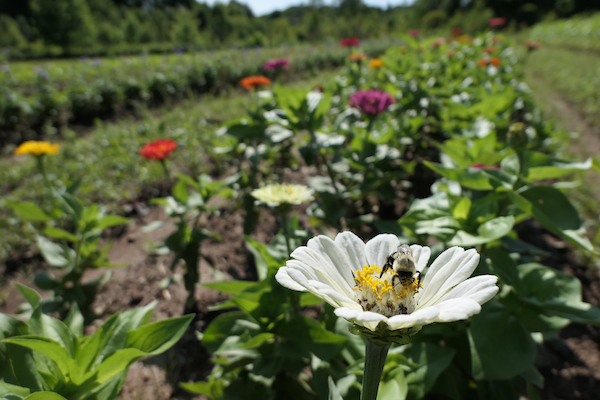
Welcome to the 2019 U-pick Flower Patch!
Workshifts scheduled for this week:
- Tuesday (6/25) 9-11am
- Wednesday (6/26) 9-11am & 6-8pm
- Friday (6/28) 9-11am
- Sunday (6/30) 9-11am
Workshift sign-up instructions may be found here.
Help your farmers pull some weeds and harvest this week! We had to cancel every shift last week due to the weather and now have some catching up to do.
If it is actively raining during the time of the shift it will be canceled.

June 23, 2019
Potluck Saturday 6/29!
by Farmer Dana
Potluck Saturday 6/29!
by Farmer Dana

Come hang out with your local farm family this weekend!
- Saturday, June 29th, 6-9pm: Potluck in the pavilion. Meet and mingle with your farmers and other CSA members. Bring a dish to share to feed six, your own place settings, and a beverage of your choice. The meal should be followed by a small fire. S'mores anyone?
- Check the calendar here.

June 23, 2019
Thus, The Wettest
by Farmer Derek
Thus, The Wettest
by Farmer Derek
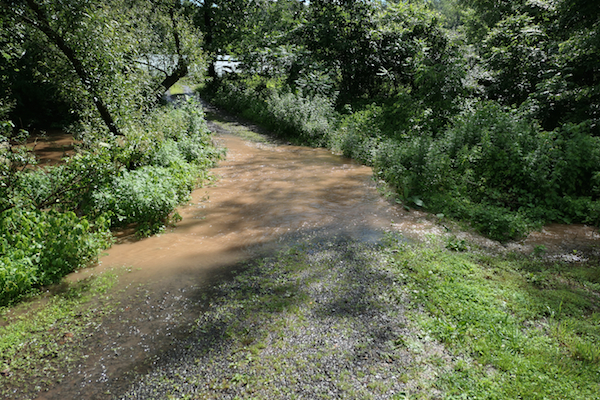
A flash flood caused by 1.1 inches of rain in a 20 minute burst on top of 3 inches already received over the prior two days. That's the path going out to the u-pick field.
And just like that this May/June combo is out wettest in 11 years. This "new norm" is beginning to render these extreme rain events less exciting and less panic-inducing. If I had to pick a week to receive 4" of rain and make most field work impossible, last week was a good choice. U-pick was in a strange pause, there was a lot less transplanting to do, and I didn't have any major tractor work that just couldn't wait. However, I did have to delay by one week our order of 7,000 year 2020 strawberry plants since the ground won't be dry enough for me to finalize bed-making in time for their midweek arrival (especially with the forecast rain Monday night). Even with the record-breaking rainfall the farm and its crops and its farmers still seem to be (mostly) happy and healthy. This sunny, dry, and windy weekend is much needed, especially for the farmers.
Assuming we have a nice and dry week we have a lot on our to-do list. Tomato plants are growing by leaps-and-bounds and need another round of pruning and clipping. There's much to cultivate and some to weed. We have the regular weekly successions of beans and lettuces to plant plus zucchini and cucumbers which seem to grow twice as fast now compared to April. Regular harvests will continue and very soon big harvests will commence with carrots and garlic. Soon we'll be transitioning spring production fields to cover-cropped resting fields as we clean up and prepare for the off-season recovery. For now we'll enjoy this ever-so-slight pause in the workload and gear up for another productive push when the weather allows. Happy summer!

June 23, 2019
Summer Salads
By Linda Dansbury
Summer Salads
By Linda Dansbury
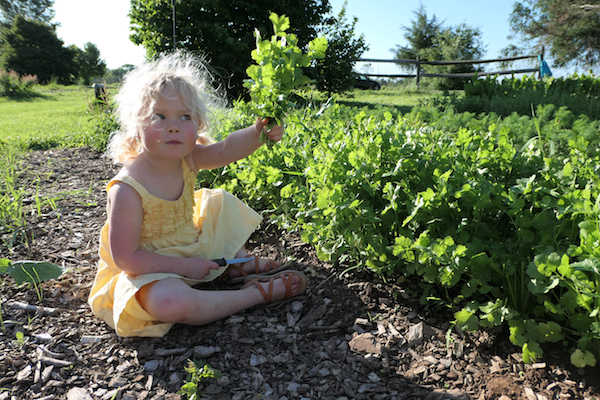
Freshly harvested cilantro from the herb garden.
The fresh harvest from the farm provides an opportunity to easily add extra servings of veggies to our daily diet. One of the things I do is to put together a serving of cut up veggies to have with my lunch each day. Recently, I have been using the turnips, kohlrabi, peas (gone, unfortunately), cucumbers. When I come home in the evening and am hungry, instead of a bag of chips, I get the veggies out - making or keeping a tub of hummus or Garlic Scapes with White Bean Dip adds flavor and protein to your snack. Please share how you are enjoying your harvest by emailing me at lindadansbury@comcast.net. And please put Anchor Run in the subject line.
Swiss chard, garlic scapes, scallions - I sauteed local mixed mushrooms with chard stems and once-chopped garlic scape. When browned, added the chopped up chard leaves and cooked just until wilted. Topped with chopped scallions. This turned out to be a really delicious combo - I only added a little salt and pepper.
Summer squash, garlic scapes, romaine lettuce, parsley - made the Warm Sausage and Summer Squash Salad. As I said last week, this is an easy and delicious 1 pan meal. I used Italian sausage from Hershberger Farm.
Summer squash, garlic scapes, romaine lettuce, parsley - made the Warm Sausage and Summer Squash Salad. As I said last week, this is an easy and delicious 1 pan meal. I used Italian sausage from Hershberger Farm.
Beets, beet greens, scapes, scallions, parsley - made the Roasted Beet and Beet Green Risotto. One evening when I was already using the oven I roasted 2 weeks worth of beets, saving the tops. When cooked and cooled, I peeled them and placed in plastic container. Last night, we had the risotto.
Roasted beets, scallions, herbs - made Pickled Beets using some of the roasted beets beets from above. I like adding some herbs to my mix. Pickled beets keep in the fridge for several weeks - if you don't eat them before then!
Turnips, garlic scapes, greens, including, Swiss chard and Italian dandelion, herbs - sliced up the larger turnips and left the tiny ones whole. Sauteed in olive oil until getting browned and tender. During the process, added Swiss chard stems and chopped garlic scape. When the turnips were browned and getting tender, added slivered chard and dandelion. When wilted, added a bit of sesame oil and topped with chopped cilantro.

June 23, 2019
Love to our Tiny Turnips!
By Linda Dansbury
Love to our Tiny Turnips!
By Linda Dansbury
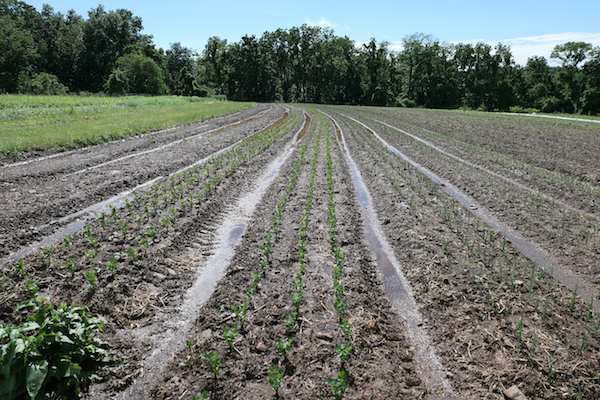
Sunshine puddles in the celeriac and leek patch. Unfortunately the deluge was not followed by a rainbow.
Every so often I ask our farmers if there are crops that people are asking about - Derek said that it seems people are reluctant to take the beautiful, little white orbs known as hakurei turnips. I absolutely love these little mild veggies because of their flexibility. Raw, they are delicious to eat all by themselves or dipped into your favorite dips or hummus. I also slice them and add to salads as you would radishes.
They also cook up easily and deliciously - sliced thin, add to a pan in which a little olive oil has been added. When tender and slightly browned, add garlic scapes and chopped greens and saute until greens are wilted and turnips are desired tenderness. The turnips caramelize when they brown and it almost sweetens the flavor. Add soy sauce or sesame oil and then finish off with chopped scallions and fresh herbs. A squeeze of fresh lemon juice also works well. See my note in How I enjoyed my Harvest.
Turnips are also delicious roasted. Cut in half or leave whole if small, toss in olive oil, salt and pepper, and roast till browned and tender. When they come out of the oven, toss with your favorite fresh herbs. Yum.
There are also several recipes, both raw and cooked preparations, on this site, so check out the Asian Turnip/Cabbage Slaw, Asian Turnips with Miso, Shaved Turnip Salad, and more!

June 16, 2019
Goodbye Peas & Strawbs, Hello Cukes & Zukes
by Farmer Dana
Goodbye Peas & Strawbs, Hello Cukes & Zukes
by Farmer Dana
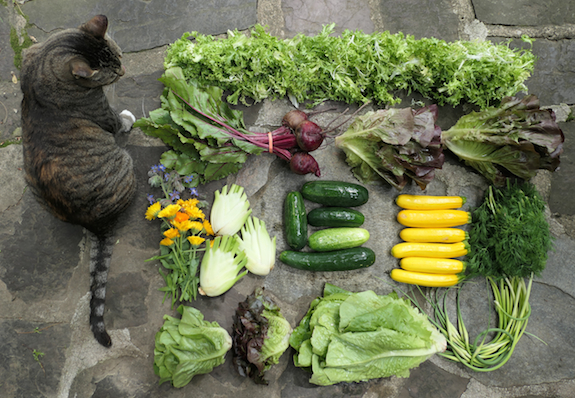
Harvest #6 (Week B) should include beets, head lettuce, romaine lettuce, garlic scapes, cucumbers, yellow and green zucchini, hakurei turnips, fennel, radicchio, kale, chard, Italian dandelion, endive, cilantro, dill, and parsley. U-pick will probably only include herbs this week as we wait on raspberries and beans to ripen and mature.
A pick up room board note: When we write, for example, "1 lb total combined weight from:" we mean you may take up to 1 pound total from the listed options which could be 1 lb of a single listed item or any combination of the listed items totaling 1 pound.
A pea note: The snow and snap pea crops suffered this year. It was the worst production in our 11-year tenure for sure. We are certain it was due to the early onset of pea root rot which is caused by organisms in the soil or potting mix or even compost (Fusarium, Rhizoctonia, or Aphanomyces). Normally a simple crop rotation plan ensures crop success. Last year at this time each member was receiving 2 quarts of peas. Please accept our apologies for this disappointment. We'll plan for a better yield next year.

June 16, 2019
Workshifts for Week of 6/17/19
by Farmer Derek
Workshifts for Week of 6/17/19
by Farmer Derek
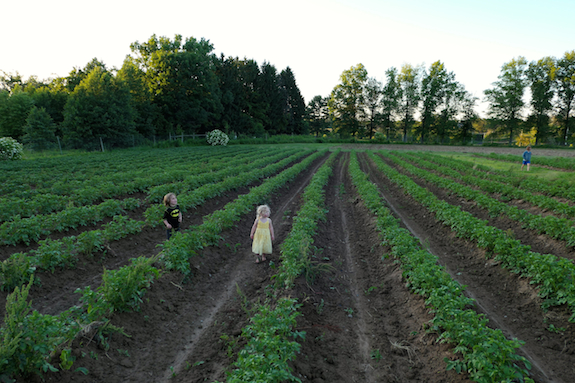
Potatoes cultivated and hilled, all 9,000 feet of them.
Workshifts scheduled for this week:
- Tuesday (6/18) 9-11am
- Wednesday (6/19) 9-11am & 6-8pm
- Friday (6/21) 9-11am
- Sunday (6/23) 9-11am
Workshift sign-up instructions may be found here.
Take advantage of these awesomely cool temperatures! Help your farmers pull some weeds and harvest this week. As of now it looks like there is a 'chance' of rain each day this week. If it is actively raining during the time of the shift it will be canceled.

June 16, 2019
Upcoming Events
by Farmer Dana
Upcoming Events
by Farmer Dana
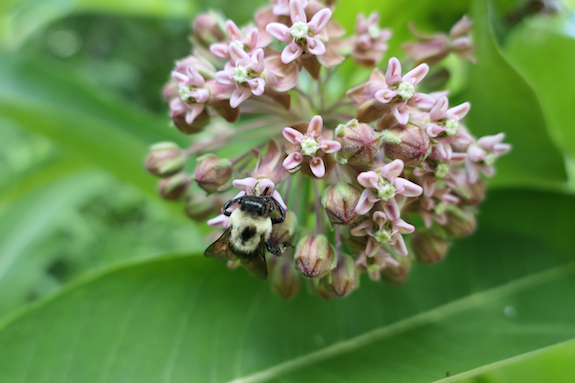
If you've never sniffed a milkweed flower, you absolutely must do so; there's perhaps nothing that smells better.
- Saturday, June 29th, 6-9pm: Potluck in the pavilion. Meet and mingle with your farmers and other CSA members. Bring a dish to share to feed six, your own place settings, and a beverage of your choice. The meal should be followed by a small fire. S'mores anyone?
- Check the calendar here.

June 16, 2019
Summer Solstice Upon Us
by Farmer Derek
Summer Solstice Upon Us
by Farmer Derek
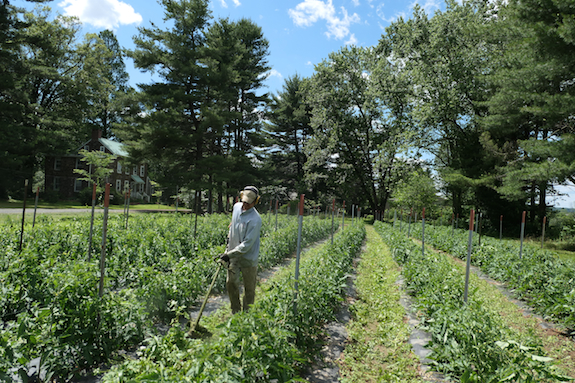
Putting the (temporary) finishing touches to a cleaned up field tomato patch.
As we approach this year's summer solstice the farm is in a good place, a good state, in this time as we make our revolution around our sun. As an organic produce farmer I'm out and about under the sun's gaze for much of the trip around the sun and I'm often transfixed by the beauty and grace that is present in the natural and agricultural 'scapes around the farm. Especially this time of year when multiple shades of green glisten and glow as most plants work hard to maximize photosynthesis and the creatures that share this space frolic and call as they raise their young or attempt to find a partner to do so. It's often easy to overlook this subtle beauty in the 'natural' world and I feel very lucky to be around it and see it while I work and walk around the farm. These plants and animals (and fungi, etcetera) that I share this space with remind me that we're a part of their world, or we're a part of the same world, or we're all part of these ecosystems where we call home. And we better do a decent job to take care of it for each other since we're dependent on each other while we both depend on the same space.
And to everything there is a balance, so back to production: We were quite busy last week. Celeriac, leeks, edamame, and lettuce were transplanted. Massive amounts of cucumbers and zucchini were harvested. All of the tomatoes were pruned and trellised. Peppers were staked. Watermelon and eggplant were uncovered. Walking aisles between beds were cleaned up for carrots, eggplant, peppers, and tomatoes. More seeds were sown into flats for future transplanting including broccoli, cabbage, and cauliflower. Sweet potatoes were cultivated and hilled. Ground was prepped for upcoming plantings of lettuce, beans, edamame, and hoop tunnel tomatoes. On the agenda for this week (if it stays dry) is finishing beds for the 2020 strawberries and the final planting of this season's zucchini and cucumbers, both of which are slated for planting the following week. We also need to transplant tomatoes, lettuce, beans, edamame, dill, and cilantro; seed; harvest; weed; cultivate; and mow.

June 16, 2019
Fennel and squash
By Linda Dansbury
Fennel and squash
By Linda Dansbury
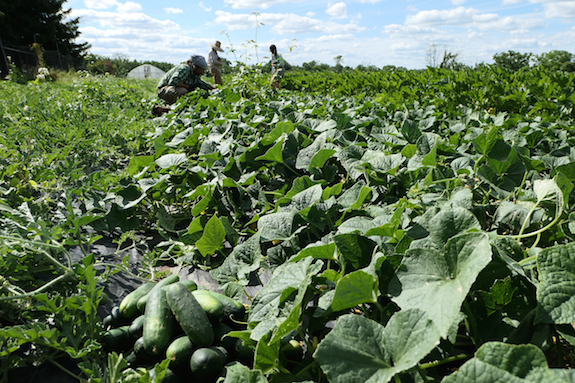
Cucumber harvest has begun and will hopefully continue for a couple of months.
The pick up room is so pretty with all of the colorful veggies!
A quick note on the squash - the yellow and green are interchangeable in recipes - so even when a recipe calls for zucchini, which is a green squash, you can use the yellow ones too. I like using a combination because it looks so pretty. Don't peel them! The skins are tender and contain a lot of important vitamins and minerals. There are several really nice summer squash recipes on this site. One of my favorite summertime meals is Warm Summer Squash and Sausage Salad. It is a one pan dinner and perfect to do now with the wonderful heads of romaine lettuce we are receiving.
Fennel makes its first appearance in our share this week. Fennel is in the parsley family, and provides good amounts of vitamin C, iron, fiber, and potassium.
All parts of the fennel plant—bulb, stalk, and the feathery fronds—are edible, and will add texture and flavor to salads, slaws, pastas, and more. Thinly sliced raw fennel bulb adds a sweet licorice flavor and crunchy texture to salads. To slice the bulb, stand it on the root end and cut vertically with a sharp knife or mandolin. To soften the flavor of the bulb, try braising, sautéing, roasting, or grilling it.
Fennel stalks can take the place of celery in soups and stews, and can be used as a "bed" for roasted chicken and meats. Fennel and seafood form a delicious combination. Use fennel fronds as a garnish, or chop them and use as you would other herbs, like dill or parsley. There are many fennel recipes on this site - both raw and cooked. Or, try the new recipe Salmon and Fennel with Roasted Lemon Vinaigrette using your Wild for Salmon fish!

June 16, 2019
Great Cooking Weather
By Linda Dansbury
Great Cooking Weather
By Linda Dansbury
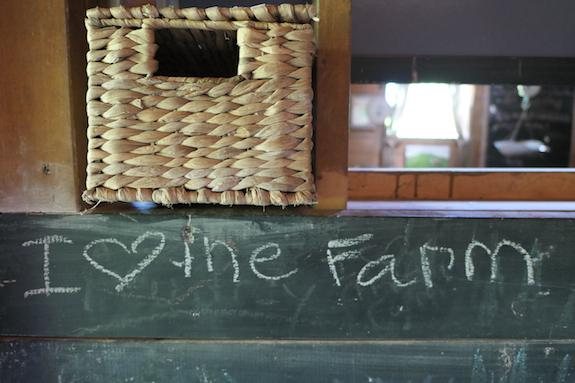
This past week was perfect for cooking indoors and outside and then sitting outside for dinner. Share with the rest of membership how you used your harvest by emailing me at lindadansbury@comcast.net and please put Anchor Run in the subject line.
Summer squash, basil, parsley, scallions - grilled all my summer squash, ate a few one night and then the next day I cut the rest up into bite sized pieces, and added to pasta. Chopped up the rest of the listed items, and then drizzled a bit of balsamic vinegar and good quality olive oil. Topped with some crumbled local feta cheese.
Garlic scapes, peas, cilantro. scallions - made stir fried rice with leftover rice. Blanched peas for 1 min. To a pan put oil and scapes for 30 seconds, then added the peas and eggs and stirred the eggs around. When eggs nearly cooked, added rice and broke that up, sprinkled some soy sauce and sesame oil and mixed well. Served with thinly sliced scallions and chopped cilantro.
Kohlrabi, turnips, chard, bok choy, scallions, garlic scapes, cilantro - made the Asian Cole Slaw that is on this site. Yum!

June 9, 2019
Lettuce Play the Beet
by Farmer Dana
Lettuce Play the Beet
by Farmer Dana
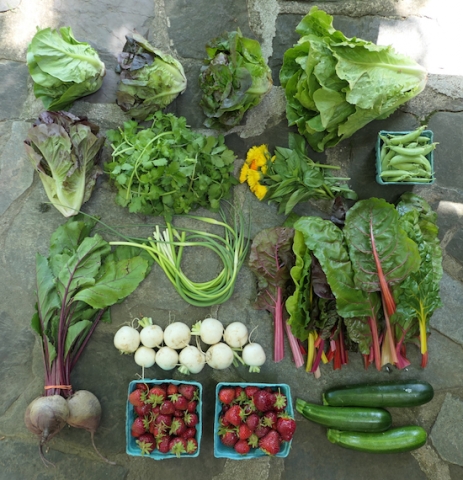
Harvest #5 (Week A) should include garlic scapes, yellow and green zucchini, romaine lettuce, head lettuce, kale, chard, endive, Italian dandelion, parsley, dill, cilantro, hakurei turnips, kohlrabi, beets, and strawberries. U-pick should include strawberries, snap peas, and herbs.

June 9, 2019
Workshifts For This Week
by Farmer Derek
Workshifts For This Week
by Farmer Derek
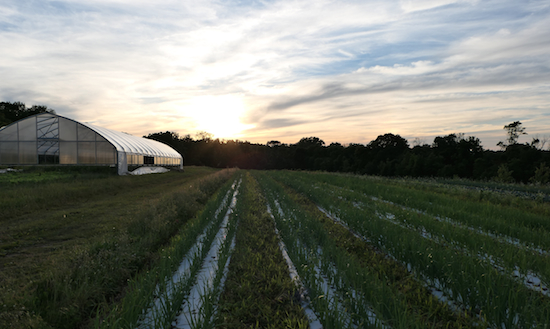
The onion patch at sunset. It was successfully weeded last week thanks to workshifts and farm staff.
Workshifts scheduled for this week:
- Tuesday (6/11) 1-3pm
- Wednesday (6/12) 9-11am & 6-8pm
- Friday (6/14) 9-11am & 1-3pm
- Sunday (6/16) 9-11am
Workshift sign-up instructions may be found here.
Take advantage of these relatively cool late spring temperatures! Help your farmers pull some weeds and harvest this week.

June 9, 2019
Upcoming Events
by Farmer Dana
Upcoming Events
by Farmer Dana
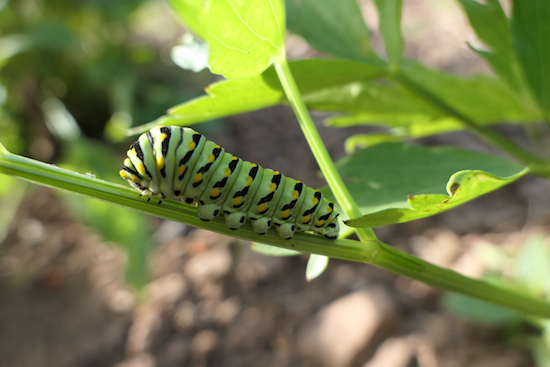
Join this swallowtail larva for a meal at the farm!
- Saturday, June 29th, 6-9pm: Potluck in the pavilion. Meet and mingle with your farmers and other CSA members. Bring a dish to share to feed six, your own place settings, and a beverage of your choice. The meal should be followed by a small fire. S'mores anyone?
Check the calendar here.

June 9, 2019
Hustle and Bustle
by Farmer Derek
Hustle and Bustle
by Farmer Derek
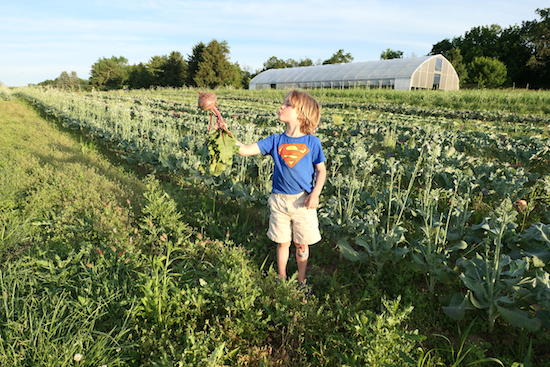
Super beet!
The marathon continues with intermittent sprints. We've had pretty amazing weather the past week and a half which has allowed us to stay on schedule and accomplish most of the tasks that make up our to-do list. Last week we began the perpetual tomato pruning and trellising which will occupy a lot of our time over the next month or so. Each plant gets pruned to 1 or 2 leaders and each leader gets clipped to a wire that is supported by 7' t-posts (we have around 2000 tomato plants on the farm). We also transplanted successions of lettuce, dill, cilantro, zucchini, cucumbers, cantaloupe, basil, edamame, beans, sunflowers, and scallions. The dry weather enabled us to hoe and weed where needed and with the help of workshifts we finished cleaning up the onion patch. This week we'll continue the steady march of spreading plants around the farm by transplanting more lettuce, beans, and edamame as well as leeks and celeriac for fall harvest. Strawberry plants for a 2020 harvest will arrive in a couple of weeks so I'll be busy getting beds ready for those 7,000 plants. We're already preparing for fall crops of broccoli, cauliflower, cabbage, etc etc by spreading compost and doing an initial chisel plow to incorporate the lush cover crops and compost into the soil. The robust organic matter needs some time to mellow and break down by the beneficial microbes and bacteria in the soil. After a rain event or two we'll mix the mixture around again to stimulate additional decomposition, wait for another rain event, then begin the process of making raised beds. All in all it's a 1-2 month long process to finalize beds for planting into.

June 9, 2019
The Freshest Food
By Linda Dansbury
The Freshest Food
By Linda Dansbury
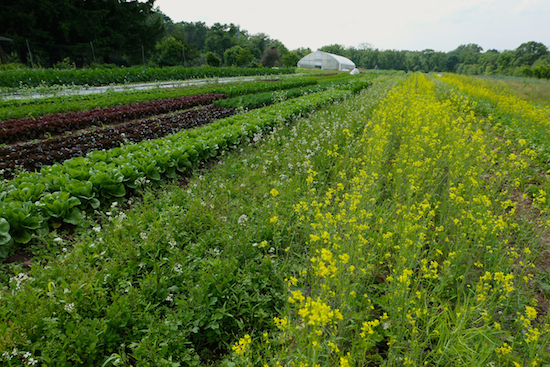
Flowering arugula, greens mix, and broccoli raab contribute additional benefits to the farmscape: food for pollinators and eye candy for creatures that visually appreciate flowering plants.
This week was pretty crazy so I wasn't able to cook a lot of different things but I certainly ate well. How did you enjoy your harvest? Please share with membership by emailing me at lindadansbury@comcast.net. And please put Anchor Run in subject line so I can find your message. Here are a few ways I enjoyed my harvest.
Spring garlic, chard, kale, escarole - made a simple but yummy dish by slightly cooking chopped garlic with chopped chard stems, then added a large pile of mixed, chopped greens. Added salt and pepper to taste - a bit of red pepper flakes is delicious too. Let the greens partially wilt, then made "wells" in the pan and cracked eggs into each of the wells. Put a lid on the pan for about a minute and then check. You want the whites of the eggs to cook, but the yolk to stay runny. Lift greens and eggs onto a plate, break the eggs and mix the runny yolk into greens, forming a sauce! Top with more pepper, chopped parsley and scallions. I also love a toasted slice of local bread to go with it.
Summer squash, scallions - as you read my article through the season, you will notice that I often do squash on the grill, as I got to do for the first time last night. It is so simple and delicious! Cut squash into halves or quarters depending on the size, brush scallions and squash with olive oil. Place on hot grill and don't go too far away. Turn as each side of squash get grill marks and cook until desired done-ness. We like it with some bite left in them. Just barely char the scallions. Remove from grill, add a bit of salt and sliver of basil or chopped parsley and you are ready to eat. Leftovers are amazing in a pasta salad.
Spring garlic, turnips, escarole - I made a Moroccan dish of ground lamb and veggies over quinoa. The recipe called for carrots, but I used our little turnips instead and it did not call for greens but I added some chopped greens at the end of cooking. The dish was so delicious, with enough for leftovers - I will add even more greens when we eat it again. Maybe some chard this time!

June 9, 2019
Scapes and Beets
By Linda Dansbury
Scapes and Beets
By Linda Dansbury
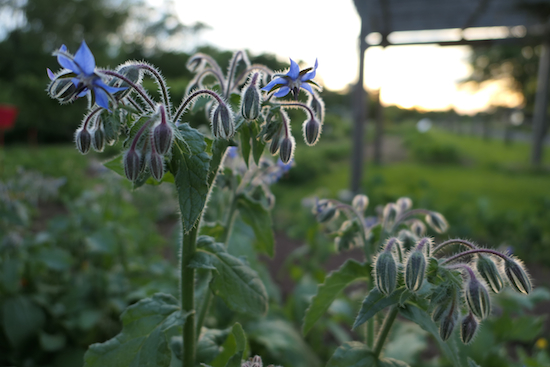
Borage is currently flowering in the herb garden. The flowers and leaves of this plant are edible, tasting mildly like cucumber.
This week we see 2 perennial favorites in the pick up room: garlic scapes and beets with tops.
Garlic scapes are the flower stalk of the garlic bulb. Farmers have been cutting the flower stalk off the plants for years so that the energy goes into forming the cloves, rather than into reproduction of the plant. As with green or spring garlic, it has to be stored in the fridge, where it will keep for a few weeks. Use it for a mild garlic flavor in any dish you like - but...don't cook it for long because the taste will be lost. If using in a cooked dish, add at the end, as you do with greens. We have a few recipes on this site for scapes, including Garlic Scape and White Bean Dip and Garlic Scapes and Greens with Pasta to help you with ideas.
Beets with tops are a wonderful treat from the farm. These spring beets are particularly sweet. When you get them home, separate the greens from the beets and store separately in the fridge. The greens can be cooked on their own or along with other greens with olive oil and garlic, adding a bit of red pepper flakes, salt and pepper. They will take 5-8 minutes to be ready to eat. Or, for a special treat, try making recipes that incorporate both the beets and greens, including Roasted Beets and Beet Green Risotto - the color of this dish is a show stopper, and it is truly delicious! Or simply make the Roasted Beets and Beet Greens dish. There are many beet recipes on this site.

June 2, 2019
Early June Veg
by Farmer Dana
Early June Veg
by Farmer Dana
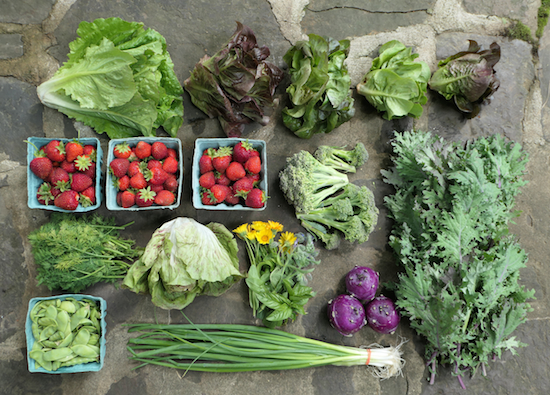
Main Season Harvest #4 (Week B) should include scallions, romaine lettuce, head lettuce, strawberries, dill, cilantro, parsley, kale, chard, endive, escarole, radicchio, Italian dandelion, bok choy, hakurei turnips, kohlrabi, broccoli, asparagus, and broccolini. Some items will be a choice and may not be available during all pick up times. U-pick should include strawberries, snow peas, and herbs.

June 2, 2019
Workshifts for Week of 6/3/19
by Farmer Derek
Workshifts for Week of 6/3/19
by Farmer Derek
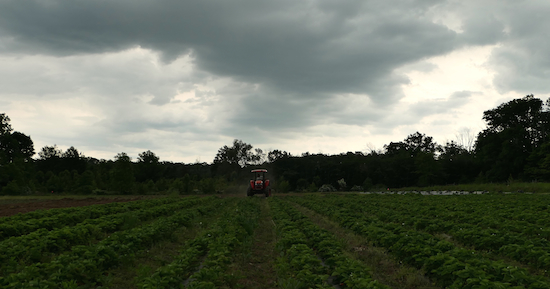
Stormy sky above the tractor.
Workshifts scheduled for this week:
- Tuesday (6/4) 9-11am & 1-3pm
- Wednesday (6/5) 9-11am & 1-3pm & 6-8pm
- Friday (6/7) 9-11am & 1-3pm
- Sunday (6/9) 9-11am
Workshift sign-up instructions may be found here.
We have some serious weeding to do so please consider lending a hand! We also need to harvest strawberries for pick up room distribution.

June 2, 2019
At Least the Frogs are Happy
by Farmer Derek
At Least the Frogs are Happy
by Farmer Derek
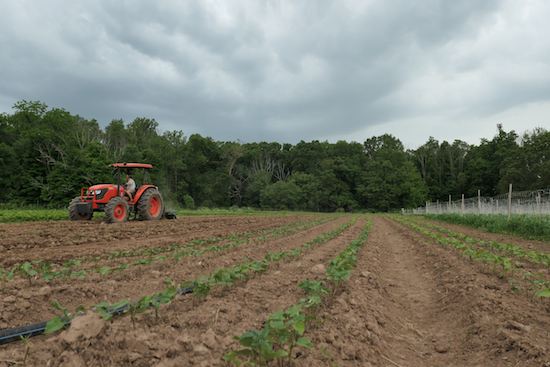
Quickly finalizing a few beds for needy bean and edamame transplants before the first of last week's rain events.
Whew. Here's hoping for some calm and dry weather. Last week's storms sure were crazy, exciting, and a bit scary. I hope you and your loved ones (and your property/possessions) made it through the storms okay. Damage to the farm could have been worse and I was expecting it to be so while watching the rain and wind pummel everything outside our windows. 'Only' 2.5 inches fell from the worst of the storms, providing the farm with enough rain to give the month of May the accolade of "second wettest May in 11 seasons". A total of 8.5" came down, 3/4" less than last May. So far I still feel lucky because that was our first deleterious rainstorm of this season. At this point last year we probably had a dozen or so. That storm was our first real test since the installation last fall of waterways and diversions to better direct the flow of water. We had some erosion but it would have been worse without those. We'll hopefully continue to make improvements to the farm's stormwater management as it appears these types of weather events are becoming more common. We must remain resilient, like Anchor Run's frog population, which was 'singing up a storm' during the storm.
Even though we battled the weather last week we were able to accomplish most of the tasks that were on our to-do list. Three thousand sweet potato 'slips' were planted as well as successions of lettuce, cantaloupe, basil, beans, and edamame. Ground was prepped for future plantings of strawberries, summer squash, cucumbers, beans, edamame, celeriac, leeks, and carrots. The onion patch was finally uncovered (ie row cover removed) after the spring threat of the pesky allium leafminer has passed. The onions have been covered since they were planted in mid-April. They've grown a lot, but so too have the weeds, and now those desperately need to be pulled out. So please join us for a workshift! We also finished harvesting the hakurei turnips and spent a lot of time harvesting strawberries for members. Additionally we moved the high tunnel off the lettuce mix to protect the heirloom tomatoes for the summer.
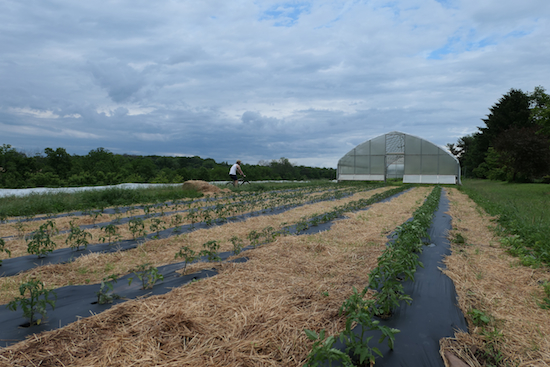
The movable high tunnel seen before it was moved to cover these heirloom tomato plants.

June 2, 2019
Enjoying the Fresh Deliciousness
By Linda Dansbury
Enjoying the Fresh Deliciousness
By Linda Dansbury
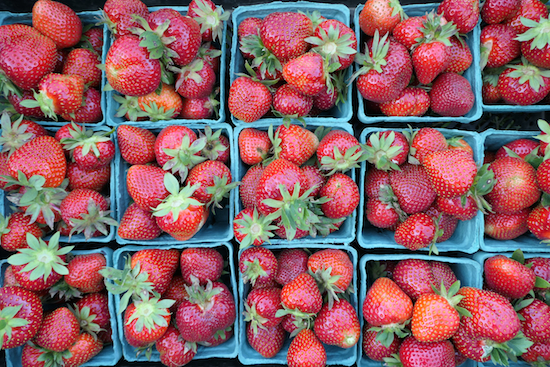
Wow, the weeks are speeding by and I am busy like the rest of you trying to figure out how to keep up with the amazing food we are receiving. Here are a few things we enjoyed eating this week. I would love to hear from you on how you enjoyed your harvest - I love to get new ideas from fellow members and even better, to share with the entire Anchor Run Community. Email me at lindadansbury@comcast.net. And please put Anchor Run in the subject line so I can find your emails.
Romaine - Enjoyed a charred romaine salad. Sliced the head into quarters, leaving the core intact so it stayed together. Drizzled with bit of olive oil and placed on a hot grill. Barely charred it on all sides, removed from grill and cut into bite-sized pieces. Place in a bowl lightly dressed with Caesar dressing. Added some fresh ground pepper. Yum.
Cilantro, mint, spring garlic - herbs help create delicious marinades for meats. The one I used this week leaned toward Middle East flavors and turned out delicious on chicken - just google marinades using herbs and you will find a lot of recipes. Use these recipes to create simple marinades (and salad dressings) rather than purchasing bottled ones.
Kale, spring garlic, cilantro - made one of my favorite go-to dishes for week night dinners - Kale Rice Bowl. I love this dish - one pan (plus another for rice), cooks in under 15 minutes. It is best made using local pastured ground pork, as opposed to a lot of what is in the grocery stores - you can really taste the difference.
Bok Choy, Swiss chard - as part of our Memorial Day celebration, I prepared Asian Cole Slaw. This is a very delicious recipe. You don't need cabbage to make it and the combo of bok choy and Swiss chard is delicious. I also added a bit of chopped parsley and cilantro for an additional burst of flavor.

June 2, 2019
A lot of new Veggies
By Linda Dansbury
A lot of new Veggies
By Linda Dansbury
I hope everyone is enjoying the delicious strawberries from the farm. They taste extra sweet to me because other local farms strawberry crops have succumbed to the extreme wet weather. The saturated soils of last fall when strawberries are planted prevented the plants from coming to a nice size; couple that with this past week's torrential rains leaving more standing water, and their berries have rotted. So, appreciate the water management actions that Anchor Run has invested in and enjoy the harvest!
This is the time of year when every week's harvest varies as more and more things mature. Some of the greens, such as broccoli raab, Italian dandelion greens, escarole and radicchio are deemed too bitter for some people. I tend to use bits of them in my mixed salads, so that the bitter hint is actually a plus. Here are some strategies to try to tame the bitterness.
Cut or slice the greens in small pieces or strips, soak in cold water in which a few ice cubes have been added for 30 minutes. This helps tame the bitterness. Likewise, blanching and/or cooking significantly cuts down the bitterness. Broccoli raab is the prime example. It’s so good when quickly sautéed with garlic and red pepper flakes, but an overload of acrid flavor can destroy the dish’s balance. To guarantee the right taste, first blanch the raab in a pot of boiling salty water until it turns bright green. Then drain the stalks and finish the newly non-bitter vegetables however you’d like.
Bitter vegetables respond well to hints of sweetness. Add a little extra sugar or honey to vinaigrettes intended for bitter veggies. Also, the combination of strong vinegar and a big pinch of salt can tame even the bitterest of bites with its own assertiveness. Look for vinegars with a lot of character: this is the right place to pour on your aged balsamic or imported sherry vinegar.
If you’re sensitive to bitter flavors and not averse to adding fat, add cheese, cream, and butter to bitter vegetables; this shields your taste buds against their boldness. Creamy gratins are good formats to look to, and strong rich cheeses, like fontina and gorgonzola, make an ideal finish for anything with bitter greens.
There are a lot of recipes on this site for the bitter greens we receive that employ these methods, so try some of them! And remember, bitter greens are extra good for your body and your digestion!

June 2, 2019
Now What?! Recap
by Gia Yaccarino
Now What?! Recap
by Gia Yaccarino
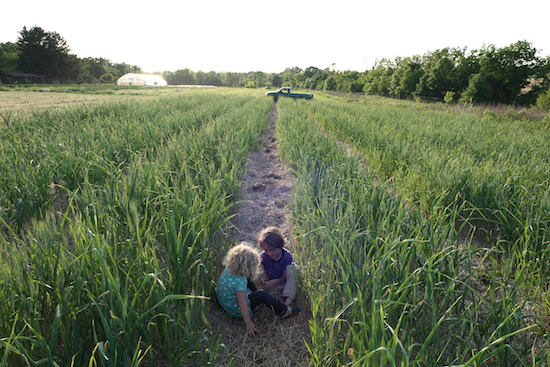
I love doing this workshop! The members who attend are always so eager to learn! This year was no different! People shared their ideas and asked lots of great questions! How to use all the lettuce definitely came up once or twice! I recommend using the salad mix first and save the full heads of lettuce until later in the week. Figuring out which greens should be used first, and which ones can wait is part of the CSA learning curve!
We talked about what types of containers to use to store our produce. I love the Rubbermaid ones with a little shelf on the bottom.
I also attempted to emphasize what a unique experience it is regarding how each member handles their share – being a CSA member is not a one-size-fits-all experience! But with that being said, we can learn soooo much from each other! So please, talk to each other in the pickup room or as you are doing your u-pick. I know that I learn new things each year from other members!
Of course, the workshop would not be complete without food! I shared BBQ Zucchini Chips and dehydrated tomatoes when we briefly spoke about using a dehydrator. I would love to hear from any member who has used their air fryer as a dehydrator!
I suggested that members use the center rib of the Kale for something like Kale Stem Pesto – which I had some to share! And I also shared a newer family favorite – Kohlrabi in a Peanut Teriyaki sauce. I promise the recipe will come in a future newsletter!
Overall, I hoped to try to encourage members to think outside the box regarding using their share. I will confess that until maybe 5 or 6 years ago, whenever Bok Choy was part of our share, the only thought I had was “make rice for stir fry”. Now I use Bok Choy in so many ways – using the leaves for a wrap, having the stem with peanut butter, or using both leaf and stem in a Mexican Casserole! Look for the recipe on the Recipe page: Bok choy Mexican casserole. Or using the Bok Choy leaves to wrap the Kohlrabi in the Peanut Teriyaki sauce mentioned above!!! Swapping out a mild green you don’t have with a mild green you do is a great way to modify a recipe! Same thing goes with bitter greens. Heck – experiment with your recipes and swap in a bitter green instead of using a mild green. Live life on the wild side!
Blanching greens to freeze and save for later was also discussed. I don’t mean to diss the turnip greens – but with all the yummy produce we are getting in our share, they are not on the top of my list of what I want to eat. But I am so grateful in the winter that I had blanched them, squeezed out all the water and froze the little ball in a Ziploc bag or a mason jar! Yes – you can use Mason Jars in the freezer! That is real canning jars – not the ones the tomato sauce comes in and just say “Mason” on the side.
I also shared my number one “go to” reference: From Asparagus to Zucchini: A Guide to Cooking Farm-Fresh. And when I say number one – I really do mean it – as in even before google!
And there were things I didn’t talk about – like using your u-pick herb share! Don’t skip over it! And speaking of herbs – I am anxiously awaiting the arrival of Papalo and Sorrel!
Thank you to everyone who attended – I had a fabulous time and I hope you did too!

POSTS BY TYPE
POSTS BY MONTH

